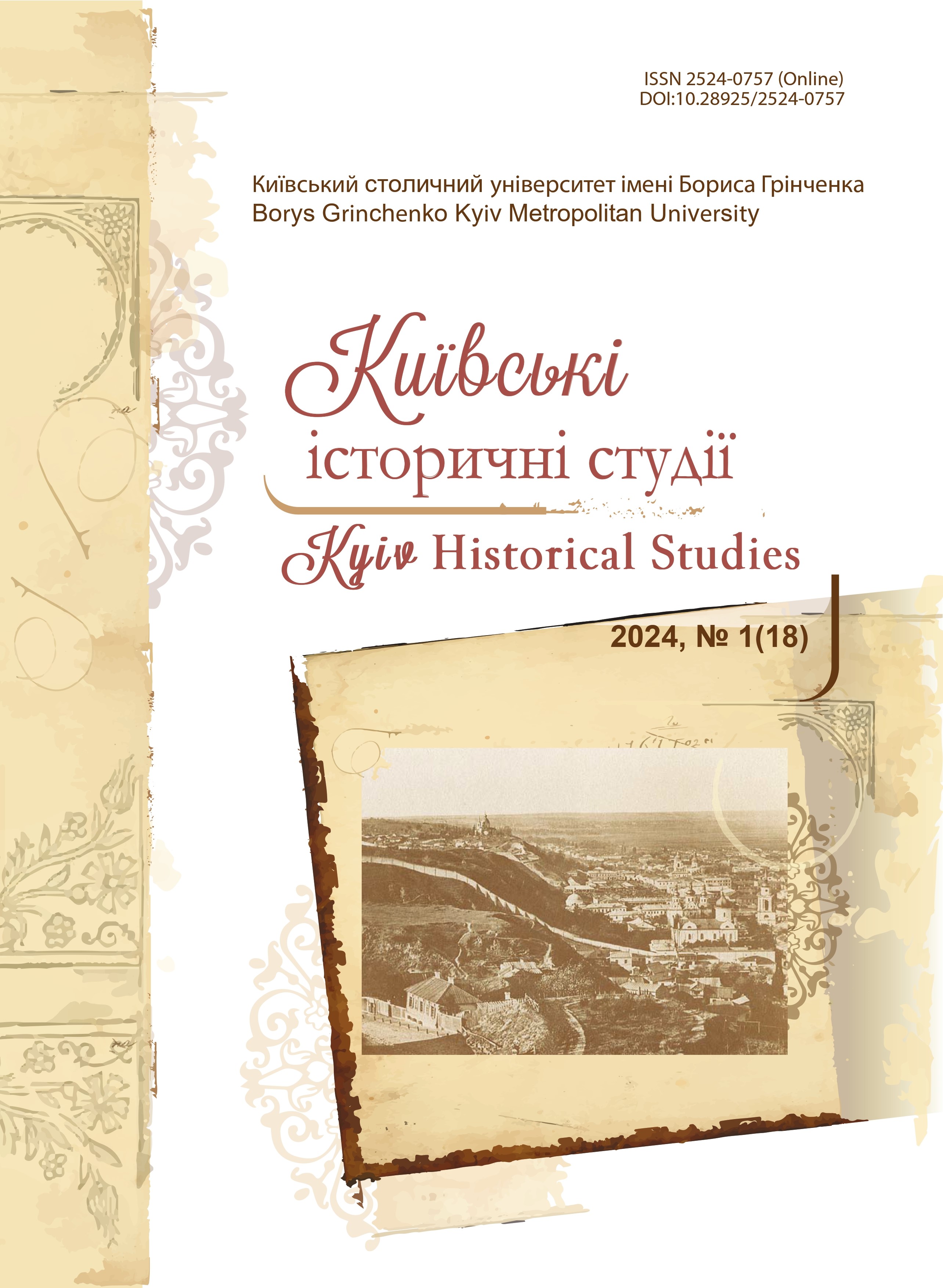The Establishment of North-Eastern Borders of Romania: International and Legal Support for Incorporation of the Bessarabia Lands into the Kingdom (end of 1919 — the 1st half of 1920)
DOI:
https://doi.org/10.28925/2524-0757.2024.16Keywords:
Paris Peace Treaty, “Bessarabia” issue, the Entente, diplomacy, National Assembly, Alexandru Vaida-Voevod, RomaniaAbstract
The foreign policy of Romania throughout the first decades of the 20th century was neither unplanned nor spontaneous. It was pursued by the Kingdom’s leadership within the framework of the idea of establishing the “Greater Romania”. Generally, the policy of official Bucharest during the war period and the period of the formation of the Versailles system of international relations was concentrated on defending national interests and gaining the status of a regional leader in the Balkans. The purpose of the article is to analyse the political struggle around the “Bessarabia” issue at the Paris Peace Conference throughout December 1919 — March 1920. Indeed, exactly this time frame became decisive for the Romanian Kingdom in terms of the recognition by the international community of its sole priority to rule Bessarabia. Great amount of relevant information and materials enabled authors of the article to analyse a comparatively short-term period of proceedings of the Paris Conference as it clearly demonstrates the tense atmosphere of the process of creating a new geopolitical map of post-war Europe. As a whole, Alexandru Vaida-Voevod’s activities in solving the “Bessarabia” problem had positive outcomes for Romania. On March 12th, the National Assembly directed the decision on this issue to the government in Bucharest. Taking into account preliminary conclusions and “yearning” of Bessarabia population the Allies in general declared for the reunification of Bessarabia and Romania. At the same time, they demanded that official Bucharest guarantee legitimate interests of Bessarabia on the same conditions as for other parts of the Kingdom.
Downloads
References
Bacsiani, A. (2007). La difficile unione: La Bessarabia e la Grande Romania 1918–1940. Roma [in Italian].
Bossy, R. (1993). Amintiri din viaţa diplomatică (1918–1940) [Memories of Diplomatic Life (1918–1940)], Vol. 1. Bucureşti [in Romanian].
Burian, A. (2003). Geopolitica lumii contemporane [Geopolitics of the Contemporary World]. Chişinău [in Romanian].
Clark, C. U. (1927). Bessarabia, Russia and Roumania on the Black Sea, New York; Copyright 2011 University of Washington. All Rights Reserved, in https://depts.washington.edu/cartah/text_archive/clark/mobile.html#C0 (Accessed on 23.06.2020) [in English].
Dobrinescu, V. F. (1991). Bătălia diplomatică pentru Basarabia. 1918–1940 [Diplomatic Struggle for Bessarabia. 1918–1940]. Iaşi [in Romanian].
Dobrinescu, V. F. & Tompea, D. (1996). România la cele două Conferinţe de Pace de la Paris (1919–1920, 1946–1947). Un studiu comparativ [Romania at the two Peace Conferences in Paris (1919–1920, 1946–1947). A Comparative Study]. Focşani [in Romanian].
Goldstein, E. (1991). Winning the Peace: British Diplomatic Strategy, Peace Planning, and the Paris Peace Conference, 1916–1920. New York [in English].
Goşu, A. (1993). Recunoaşterea internaţională a unirii Basarabiei cu România. Ioan Pelivan la Conferinţa de pace de la Paris (1919–1920) [International Recognition of the Union of Bessarabia with Romania. Ioan Pelivan at the Paris Peace Conference (1919–1920)], Revista istorică, 9–10, 39–47 [in Romanian].
Levit, I. E. (2012). Bessarabskiy vopros v kontekste mezhdunarodnykh otnosheniy (1919–1920 gg.). Parizhskaya mirnaya konferentsiya [The Bessarabian Question in the Context of International Relations (1919–1920). Paris Peace Conference]. Tiraspol [in Russian].
Mândâcanu, V. & Vacarciuc, D. (2016). Ideea națională a românilor — Reîntregirea Țării [The National Idea of the Romanian — the Country’s Reunification]. Chișinău [in Romanian].
Marghiloman, A. (1927). Note politice 1897–1924, Vol. 5, 1920–1924. [Political Notes 1897–1924, vol. 5, 1929–1924]. Bucureşti [in Romanian].
Meltyukhov, M. I. (2001). Sovetsko-polskiye voyny. Voyenno-politicheskoye protivostoyaniye 1918–1939 gg. [Soviet-Polish War. Military-Political Confrontation 1918–1939]. Moscow [in Russian].
Meltyukhov, M. I. (2014). Pribaltiyskiy platsdarm (1939–1940): vozvrashcheniye Sovetskogo Soyuza na berega Baltiyskogo morya [Baltic Bridgehead (1939–1940): The return of the Soviet Union to the shores of the Baltic Sea]. Moscow [in Russian].
Meltyukhov, M. I. (2017). Sovetsko-polskiye konflikty. 1918–1939 gg. [Soviet-Polish conflicts. 1918–1939]. Moscow [in Russian].
Meurs, van W. P. (1996) Chestiunea Basarabiei în istoriografia comunistă [Bessarabian Issue in Communist Historiography]. Chișinău [in Romanian].
Mitrasca, M. (2002). Moldova: A Romanian Province under Russian Rule. Diplomatic History from the Archives of the Great Powers. New York [in English].
Muntyan, M. A. (1977). Dunaiskaia problema v mezhdunarodnykh otnosheniiakh (1945–1948) [The Danube Problem in International Relations (1945–1948)]. Kishinev [in Russian].
Nazariya, S. M. (2013). Vopros o Bessarabii v sovetsko-rumynskikh otnosheniyiakh v nachale 20-kh godov i popytki yego mifologizatsii v rumynskoi istoriografii [The Issue of Bessarabiain Soviet-Romanian Relations in the Early 20s and the Attempts of Its Mythologization in Romanian Historiography]. Bulletin of Dagestan State University, 4, 39–47 [in Russian].
Oprea, I. M. (1998). România şi Imperiul Rus. 1900–1924 [Romania and the Russian Empire], Vol. 1, Bucureşti [in Romanian].
Papers Relating to the Foreign Relations of the United States, The Paris Peace Conference 1919 (1946), Ed. Joseph V. Fuller, Vol. IX, Washington [in English].
Pavlova, M. S. (2016). Litva v politike Varshavy i Moskvy v 1918–1926 godakh [Lithuania in the Politics of Warsaw and Moscow in the years 1918–1926]. Moscow [in Russian].
Popenko, Ya. (2017). Romanian Diplomacy in the Struggle for Bessarabia at the Paris Peace Conference (January — May 1919). Kyiv Historical Studies, 2 (5), 10–17 [in Ukrainian].
Popenko, Ya. V. (2018). Romanian diplomacy in the struggle for Bessarabia at the Paris Peace Conference (January-August 1919), Rusyn, 53 (3), 152–171 [in Ukrainian].
Popenko, Ya. (2018). The Political Struggle for Bessarabia at the Paris Peace Conference during May-August 1919, Eminak, 1 (21), 2, 36–41 [in Ukrainian].
Popenko, Ya. (2018). “Bessarabian Question” at the Paris Peace Conference (autumn-winter 1919 year), Skhid, 4 (156), 56–60 [in Ukrainian].
Popenko, Ya. (2019). “I don’t want to mention the past here. My role is to deal with the present and look to the future”: activities of A. Vayda-Voevoda at the Paris Conference (December 1919 — March 1920)]. European Historical Studies, 12, 136–155 [in Ukrainian].
Potemkin, V. P. (Ed.) (1945). Istoriia diplomatii: v 3 t. [History of Diplomacy: in 3 volumes] T. 3: Diplomatiia v period podgotovki Vtoroi mirovoi voiny [Diplomacy during the Preparations for World War II]. Moscow-Leningrad [in Russian].
Satskyi, P. (2016). Strategic Importance of Ukrainian Ethnic Territories in the Process of Construction of Central Europe in 1920-s, European Historical Studies, 3, 113–127 [in Ukrainian].
Scurtu, I. (1996). Istoria României în anii 1918–1940. Evoluţia regimului politic de la democraţie la dictatură [History of Romania during 1918–1940. The Evolution of the Political Regime from Democracy to Dictatorship]. Bucureşti [in Romanian].
Stafi, I. (2007). Spovedaniile Basarabiei [Confessions of Bessarabia]. Chişinău [in Romanian].
Stănescu, M. C. (1999). Armata română și unirea Basarabiei și Bucovinei cu România. 1917–1919 [The Romanian Army and the Union of Bessarabia and Bukovina with Romania. 1917–1919]. Constanţa [in Romanian].
Suveica, S. (2014). “Russkoe Delo” and the “Bessarabian Cause”: The Russian Political Emigrés and the Bessarabians. IOS Mitteilung, 64, 3–53 [in English].
Tilea, V. (1925). Acţiunea diplomatică a României. Nov. 1919 — Mart 1920 [Romania’s Diplomatic Action. Nov. 1919 — March 1920]. Sibiu [in Romanian].
Tsimmerman, M. A. (1924). Ocherki novogo mezhdunarodnogo prava. Posobiye k lektsiyam [Essays on New International Law. Lecture guide]. Praga [in Russian].
Vinogradov, V. N. (Ed.) (2002). Za balkanskimi frontami Pervoy mirovoy voyny. [Beyond the Balkan Fronts of World War I]. Moscow [in Russian].
Vopicka, C. J. (1921). Secrets of the Balkans. Seven years of a Diplomatist’s Life in the Storm Centre of Europe. Chicago [in English].
Published
How to Cite
Issue
Section
License
Copyright (c) 2024 Ярослав Попенко, Ігор Срібняк, Наталія Яковенко, Віктор Матвієнко

This work is licensed under a Creative Commons Attribution-NonCommercial-ShareAlike 4.0 International License.
Authors who publish in this journal retain the right of authorship of the work and give to the journal right of first publication of this work under the conditions of Creative Commons: Attribution-NonCommercial-ShareAlike 4.0 International (CC BY-NC-SA 4.0), which allows others freely distribute the work published with reference to the authors of the original work and the first publication of this magazine.














